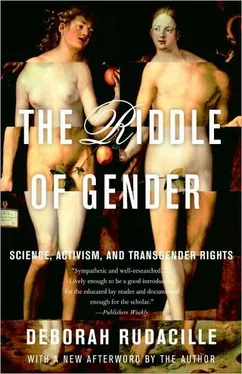And in 1920, Hirschfeld began referring patients for sex-reassignment surgery. Though a few surgeons had already carried out some incomplete sex-reassignment surgeries in Berlin and in the United Kingdom—removing the sexual organs of their patients without attempting to create new genitalia—the first complete surgeries, encompassing not only the removal of the male sex organs but the creation of a vagina and labia, were carried out by Hirschfeld’s colleagues at the institute, Ludwig Levy-Lenz and Felix Abraham. Abraham published an article reporting the surgeries (with before-and-after photographs) in the journal Zeitschrift fur Sexualwissenschaft in 1931. One of the first to undergo the surgery was a longtime housekeeper at the institute, Dorchen (formerly Rudolf) Richter.
Even people who thought themselves sophisticated and open-minded sometimes found Hirschfeld’s approach to “sexual intermediaries” disturbingly liberal. Christopher Isherwood, for example, provides an amusing and instructive account of his first encounter with the patients and staff at the Institute for Sexual Science. The young writer, who saw himself as a gay sexual adventurer, liberated from middle-class standards and sensibilities, found himself definitively “out-queered” by the institute’s staff and guests. “I remember the shock with which Christopher first realized that one of the apparently female guests was a man. He had pictured transvestites as loud, screaming, willfully unnatural creatures. This one seemed as quietly natural as an animal and his disguise was accepted by everyone else as a matter of course. Christopher had been telling himself that he had rejected respectability and that he now regarded it with amused contempt. But the Hirschfeld kind of respectability disturbed his latent puritanism.”
Another visitor to the Institute for Sexual Science also was disturbed by the sexual intermediaries she found there, though grateful for the support and healing she found within its walls. In the fictionalized biography Man into Woman, the author, Niels Hoyer, describes the torment that drove his friend “Andreas” (in real life the Danish painter Einar Wegener) to seek out Hirschfeld in Berlin in the spring of 1930. Wegener had been cross-dressing for years, and Lili, the female self, was growing stronger and more insistent in her demands for fulfillment. “Andreas” had visited doctor after doctor, searching fruitlessly for medical assistance, until he met the Dresden gynecologist who sent him to Hirschfeld. “Some of the doctors to whom he went thought him neurotic, some thought him homosexual; but he himself denied the truth of both these diagnoses,” writes the British sexologist Norman Haire in the introduction to Man into Woman. The Dresden gynecologist “Kreutz,” on the other hand,agreed that Andreas [Einar] was probably an intermediate sexual type, furnished, by some sport of nature, with both male and female gonads. He explained that there were probably rudimentary ovaries in Andreas’ abdomen, but that these were unable to develop properly because of the inhibiting influence of the testicles which Andreas also possessed. He proposed that Andreas should go to Berlin, where certain investigations were to be undertaken. If these investigations confirmed his suppositions he promised to remove Andreas’ male organs and transplant into him ovaries from a young woman, which would, as the work of the Steinach school had shown, activate the rudimentary ovaries lying dormant in Andreas’ abdomen.
Wegener traveled to Berlin to be diagnosed definitively by Hirschfeld. His first visit to the clinic was not auspicious. “ ‘Why have I been sent here?’ he wondered. ‘What do I have to do here?’ He felt intensely uncomfortable. In this large room a group of abnormal persons seemed to be holding a meeting—women who appeared to be dressed up as men, and men of whom one could scarcely believe that they were men. The manner in which they were conversing disgusted him; their movements, their voices, the way in which they were attired, produced a feeling of nausea.”
Wegener’s meeting with Hirschfeld (called “Hardenfeld” in the book) was even more disturbing. “By means of a thousand penetrating questions, this man explored the patient’s emotional life for hours. He had to submit to an inquisition of the most ruthless kind. The shame of shamelessness is something that actually exists, he thought, during those hours, and clung to this definition, which he had once found in some philosophical work, in an effort to banish the feeling he had of standing there as if in the pillory. His emotional life was undergoing an ordeal which resembled running the gantlet. And when this torture came at last to an end, the inquisitor dismissed him with the words: I shall expect you tomorrow morning at the same time.’”
With his status as a sexual intermediary validated by Hirschfeld, Wegener was castrated, his testicles removed—probably by Hirschfeld’s colleague Felix Abraham (called “Dr. Arns” in the book). “The first operation, which only represents a beginning, has been successful beyond all expectations. Andreas had ceased to exist, they said. His germ glands—oh, mystic words—have been removed. What has still to happen will take place in Dresden under the hands of Professor Kreutz. The doctors talked about hormones; I behaved as if I knew what they meant. Now I have looked up this word in the dictionary and find that it refers to the secretions of internal organs which are important for vital processes. But I am no wiser than I was before. Must one equip oneself then, with wisdom and knowledge in order to understand a miracle?”
The “miracle” of sex reassignment continued in Dresden a few months later, when “Kreutz” removed Wegener’s penis, opened his abdomen, and found the rudimentary ovaries that provided physical confirmation of the patient’s intermediary status. In keeping with Steinach’s theories, the doctor then implanted healthy ovarian tissue from a young woman into Wegener, tissue that was rejected, requiring further surgery. Nonetheless, Lili Elbe had successfully ousted Einar Wegener, a coup for which she apparently felt both relief and guilt. “I feel like a bridge-builder. But it is a strange bridge that I am building,” Wegener (now Lili Elbe) writes. “I stand on one of the banks, which is the present day. There I have driven in the first pile. And I must build it clear across the other bank, which often I cannot see at all and sometimes only vaguely, and now and then in a dream. And then I often do not know whether the other bank is the past or the future. Frequently the question plagues me: Have I had only a past, or have I had no past at all? Or have I only a future without a past?” These were questions that would echo in the lives of later generations of transsexual people who crossed the bridge that Lili helped construct.
According to Hoyer, when Wegener’s surgeon in Dresden opened his patient’s abdomen he discovered “withered” ovaries. Einar/Lili was, in medical terms, a true hermaphrodite, possessing both testicular and ovarian tissue; this explained Wegener’s feminine mannerisms, slight build, and small breasts, and also the genital “underdevelop-ment” noted by Norman Haire in the introduction to Man into Woman. After recovering from surgery, Wegener was issued a new passport by Danish authorities, in the name of Lili Elbe. The king of Denmark declared the marriage between Wegener and his artist wife, Gerda, “null and void.” (The faithful Gerda, who had supported Wegener throughout the transformation, married a mutual friend shortly thereafter.) Another friend, called “Claude” in the book, who had known the secret of Einar/Lili for many years, then proposed marriage to Lili. She accepted, under the condition that he wait until she underwent one final surgery, one that would make her fully a woman in her own eyes.
Читать дальше












